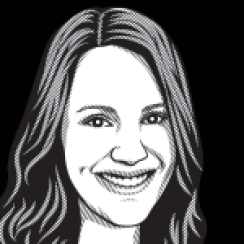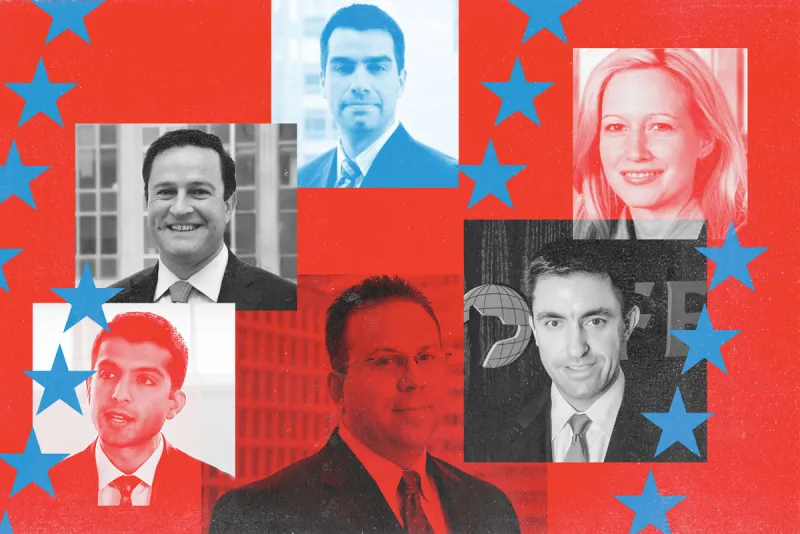When Wolfe Research chief investment strategist Chris Senyek started out on the sell side, analysts still studied hard copies of annual reports that they got in the mail.
Things are a lot different now — especially this year, when literally every aspect of the job has gone virtual. But as fellow sell-side veteran Robin Farley puts it: “Good content never goes out of style.”
In good years and bad, these analysts have earned the respect and acclaim of the institutional investors who rely on them for equity and macro research. This year they enter the All-America Research Team Hall of Fame: an elite class of analysts who have earned a No. 1 ranking ten times or more. They join research legends like Evercore ISI chairman Ed Hyman, who makes his 40th appearance on the First Team this year.
These are the new Hall of Famers.
Steven Alexopoulos, JPMorgan Chase
Financial Institutions — Banks/Midcap (No. 1)
What’s the best call you ever made?I upgraded shares of First Republic to overweight and made the company my top pick shortly thereafter. Since that upgrade in April 2011, First Republic shares have increased 297 percent, compared to 47 percent for the Nasdaq Bank Index — as well as outperformed the S&P 500, which increased 154 percent over the same time frame.
This was my best call, since I have been pounding the table on the stock for nearly a decade. It has also been a largely out-of-consensus call the entire time given the valuation of the shares. First Republic remains my top pick to this day, which is still largely out of consensus.
What’s the worst call you ever made?
Adding PrivateBancorp to the J.P. Morgan Analyst Focus List on May 23, 2008.
Even though my mantra to clients is credit, credit, credit when it comes to bank stocks, after spending a day at the company’s headquarters, I walked away more confident in the credit underwriting under a new CEO. From the time of adding PrivateBancorp to the Analyst Focus List through October 2009, when I ended up downgrading the stock to neutral, shares have declined 74 percent versus a 35 percent decline in the Nasdaq Bank Index. Although pressure on credit stemmed from the legacy portfolio, rather than the new loans on which I had placed my focus, in this case I should have taken my own advice that when it comes to bank stocks, what matters most is credit, credit, and credit.
How has your job changed since you started out?
Given the sources of information available to buy-side investors, which increased exponentially with the rise of the internet, for analysts to be effective they must provide significant, differentiated value.
For example, analysts must conduct proprietary research, which adds significant value to the buy side. Along these lines, our franchise has become known for conducting deep dives into the industry and companies that we follow.
How has your job changed since the pandemic started?
Now that most of us are living at work rather than working from home, what’s changed the most is the frequency of virtual meetings and client interactions, which have each increased substantially. In fact, both the quantity of meetings we are hosting and the attendance from investors have increased notably during the pandemic. While the volumes have increased notably, however, the day-to-day work has actually remained fairly constant given [that] the job of a research analyst can easily be accomplished remotely. Prior to the pandemic, much of my research was conducted on the road; now instead of a hotel room, it’s a home office.
If a client needed to know one thing about your area of coverage, what would it be?
If you’d like to have a long career investing in bank stocks, these are the five items you need to worry about, in order: credit, credit, credit, rates, and regulatory matters.
Robin Farley, UBS
Consumer — Leisure (No. 1)
Consumer — Gaming & Lodging (Runner-up)
What’s the best call you ever made?The best calls are the tough calls, when everyone else is saying something different and you’re not following the herd. They’re often ones where there’s a lot of pushback initially, but over time it plays out.
For a while we had a neutral on Harley-Davidson. It was definitely against the consensus view. We were flagging a lot of the company’s challenges having to do with average rider age. The core customer was aging, and [Harley] wasn’t resonating with younger generations. And we were the first to say that about this very iconic brand.
It took a couple of quarters for it to be clear it wasn’t just a bad quarter here, bad quarter there. There was the bigger picture people were missing.
What’s the worst call you ever made?
A while ago we had a sell rating on Choice Hotels, thinking that Airbnb would hurt hotels that cater to leisure travelers. That didn’t happen.
Sometimes disrupters don’t impact things in the exact way you think they will. Also, the growth in demand for travel pre-Covid continued to outpace the growth in supply.
How has your job changed since you started out?
How we deliver the message has changed over time, but good content has always mattered.
I also think the demands have gotten greater in terms of how directly clients want to be connected to your level of industry knowledge. They want to hear the conversations you’re having; they want to feel like they’re part of the primary research process.
How has your job changed since the pandemic started?
The depth of dialogue with clients matters more than ever. Analysis and insight mattered more this year. The job is less about seeing clients and entertaining clients and more about giving them the analysis they need to make decisions.
If a client needed to know one thing about your area of coverage, what would it be?
People will want to travel again.
Marko Kolanovic, JPMorgan Chase
Economics & Strategy — Equity-Linked Strategies (No. 1)
Economics & Strategy — Thematic Research (No. 1)
What’s the best call you ever made?Calls that were highly accurate were daily short-term S&P 500 calls based on options hedging and systematic strategies flows, such as in 2011, 2015. This year an important call — and maybe the biggest of my career — was during the peak of the pandemic in late March and early April: the call that the S&P 500 would quickly recover to all-time highs this year. At the time, this was handily dismissed, but it already materialized in August.
What’s the worst call you ever made?
Focusing on this year, we believed in January that the trade deal, a global manufacturing recovery, and various technical factors would lead to a strong rally of value stocks. Then came Covid-19 and lockdowns in February, so a global recession sent value to new lows. We still think [the rally] will happen soon — later this year or early next.
How has your job changed since you started out?
The job has changed significantly, as did the markets and the world around us. I started focusing on equity derivatives and quantitative strategies, and putting them in the context of stock fundamental developments. Over time these quantitative market forces became stronger and almost entirely intertwined with macro developments — such as central bank moves and politics — and developments across all asset classes. Analyzing macro developments, market microstructure, big data, and machine learning is a big part of what I do.
How has your job changed since the pandemic started?
Given the pandemic became the main driver of virtually all market segments, one needed to quickly master how to analyze and apply the incoming data behind the pandemic. We published several analyses and data science papers, using traditional and big data, in March and April — correctly forecasting Covid-19 mortality rates, hospitalization trends, and population immunity rates in the Northeast. This, alongside analyses of central bank stimulus, positioning, and liquidity, was one of the key inputs for our call for a quick market recovery.
If a client needed to know one thing about your area of coverage, what would it be?
It is multidisciplinary coverage. It relies on scientific methods — math, data science — but also incorporates macro, fundamental, and microstructure analyses such as flows, liquidity, and positioning.
Tycho Peterson, JPMorgan Chase
Health Care — Life Science & Diagnostic Tools (No. 1)
What’s the best call you ever made?Illumina. The company had just closed the Solexa deal in 2007, and people did not fully appreciate the transition from arrays to sequencing, not to mention Illumina’s competitive edge versus others.
What’s the worst call you ever made?
We went underweight Myriad too early, and it ran to [about] $50. It has played out now, but that was painful.
How has your job changed since you started out?
Information travels much faster. When I first started in 1999, we had one FactSet machine for the department and earnings notes went out a day after companies reported. There were also fewer hedge funds then.
How has your job changed since the pandemic started?
It has gotten a lot more intense in terms of the hours. Some of that is a function of covering diagnostics in the midst of a pandemic, but it has also been harder to separate from work since there is no commuting, travel, etc.
From a day-to-day perspective, we have been doing a lot more expert calls and surveys, in addition to Zoom calls with clients. Capital markets have also been busy, since every company that can seems to be raising money ahead of the election.
If a client needed to know one thing about your area of coverage, what would it be?
This is where a lot of the innovation is happening in health care right now: earlier disease detection, cellular and spatial analysis, low-cost DNA sequencing, tools to develop breakthrough vaccines and therapies. I am incredibly excited about the future of the life science tools and diagnostics space.
Umer Raffat, Evercore ISI
Health Care — Biotechnology/Large-Cap (No. 1)
Health Care — Pharmaceuticals/Major (No. 1)
Health Care — Pharmaceuticals/Specialty (No. 1)
What’s the best call you ever made?By far the best call I ever made was my decision to join equity research covering the very innovative biotech and pharma space under the great Mark Schoenebaum.
What’s the worst call you ever made?
Valeant has to be the worst call I ever made. It also has to be the one stock where I learned the most. What was most unusual was that a majority of allegations weren’t accurate. However, once the noise level amplified to the levels it did, things changed very fast, ranging from managed care’s decision to completely change the P&L to valuation metrics completely switching.
How has your job changed since you started out?
The pace of innovation in biopharma is at an all-time high, and as a result, influx of capital into the space is at an all-time high. As a result, keeping up with the space requires staying on top of an unprecedented amount of companies and clinical trials.
How has your job changed since the pandemic started?
Since biopharma has been at the forefront of Covid, tracking the vaccines and therapeutics has created an entirely new sector of sorts. What’s even more unusual is the sheer amount of attention being paid by generalist investors to emerging immunological and clinical data.
If a client needed to know one thing about your area of coverage, what would it be?
Innovation.
Chris Senyek, Wolfe Research
Economics & Strategy — Accounting & Tax Policy (No. 1)
What’s the best call you ever made?A few years back we were way out of consensus on our view that the Trump tax cuts would occur and that they would have a positive impact on the market and company earnings.
What’s the worst call you ever made?
Underestimating the fallout from the financial crisis in 2008. It went on longer than we thought it would because we underestimated how slow policy makers would move to respond.
How has your job changed since you started out?
When I first started, I would wait for financial information and annual reports to arrive in the mail from investor relations departments and analyze [them] over weeks. Now everything is electronic and quickly incorporated into stock prices. We’re inundated minute by minute with information, and we have to separate what’s important and what’s not important.
How has your job changed since the pandemic started?
The days are long and the weeks are short. I find myself constantly pivoting to new data points. One minute it looks like the world is going to fall apart, and the next minute the Fed is announcing an action that shores up the market. This year there’s been numerous cross-currents with policy, with macro, with micro. We’ve got the vaccine; we’ve got Biden’s tax plan; we’ve got companies potentially going bankrupt. It has been challenging to weigh the importance of different factors on the market.
At the same time, [I’m] mindful that when businesses are challenged, there is increased pressure for companies to push the outer edges of aggressive accounting.
If a client needed to know one thing about your area of coverage, what would it be?
We’ve been inundated with questions on the impact of tax policy changes from a Biden presidency and expect to be very busy analyzing tax policy proposals over the coming years — regardless of who wins.







